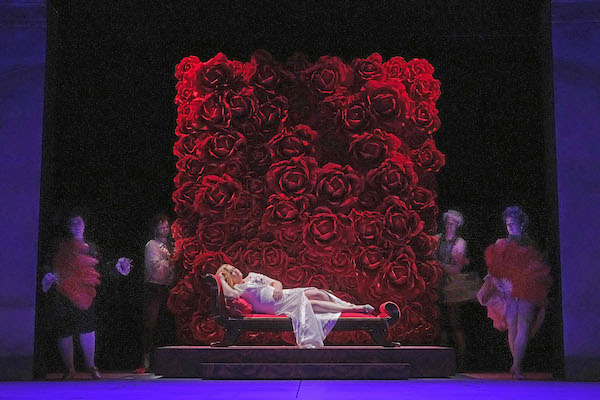Wolf Trap Opera brings vocal and visual splendor to Handel’s “Semele”

Esther Tonea in the title role and Lunga Eric Hallam as Jupiter in Handel’s Semele at Wolf Trap Opera. Photo: Ken Howard
The summer opera season is off to an auspicious start with a rare staging of George Frideric Handel’s Semele by Wolf Trap Opera Company. Seen Sunday afternoon in the Barns at Wolf Trap, this production features a strong young cast with no weak links among them. The work, updated to a contemporary setting, is presented with only a few musical cuts.
The title character is a mortal woman seduced by Jupiter, much to the consternation of her father, Cadmus, and the man she was betrothed to marry, Athamas. The god’s jealous wife, Juno, tricks the girl into demanding Jupiter appear to her in his godlike form. The experience is fatal, but Semele gives birth to a divine son, Bacchus, who rises from the ashes of her body.
Handel’s Italian opera enterprise had gone down in flames in 1741, leading the canny German-born composer to create a new oratorio franchise that yielded some of his finest works. Semele, premiered in concert form at Covent Garden during the Lenten season of 1744, represented a mixture of the two genres. Handel recycled a libretto by William Congreve, set as an opera by John Eccles around 1706 but never staged, and reused some older music, by himself and others.
Esther Tonea brought musical sensitivity to Semele’s tender arias. When it came time for the vocal fireworks, as in the Act I showstopper “Endless pleasure, endless love,” the California-born soprano deployed an evenly balanced voice, well into the high range. Her confident stage presence encompassed both humorous moments and the vain flightiness of the mortal woman who reaches too high.
Lunga Eric Hallam’s Jupiter proved the major find of the cast. The South African tenor had a majestic ring when needed, but he impressed even more in his floated head voice, put to remarkable use in the work’s most famous aria, “Where’er you walk.”
As the bitter goddess Juno, the versatile mezzo-soprano Emily Treigle, granddaughter of the famous bass Norman Treigle, chewed the scenery musically with extravagant runs and ornamentation, and in her over-the-top acting. In the same double-casting that Handel used at the premiere, Treigle also took the part of Ino, Semele’s overlooked sister, in a more demure characterization. The overlap of roles also helped make Juno’s “disguise” as Ino more believable, when she tricks Semele into her downfall.
Soprano Véronique Filloux, already familiar to local audiences, thrilled with high-flying exploits as Iris, costumed here as a sort of goofy Willy Wonka figure (costume design by Rooth Varland). Mezzo-soprano Kathleen Felty gave a sensitive rendition of Athamas, the prince who tries to marry Semele and ends up happily with her sister. Sung by a countertenor at the premiere, the role had a plausibly masculine feel as incarnated by Felty.
Bass Eric Lindsey, following Handel’s other double-casting from the premiere, was hilarious as both the irritated Cadmus, who sees his daughter’s wedding ruined, and as Somnus, the god of sleep who helps Juno access Semele’s hiding place. Tenor Samuel Krausz, a studio artist singing mostly in the chorus, had a brief solo turn as Apollo, who ties up the story’s loose ends at the conclusion.
Handel’s score is filled with musical delights, not least the many choruses, a signature element of the composer’s oratorios. The ensemble of studio artists acquitted themselves admirably in this role, carrying out the staging’s sometimes over-elaborate actions while singing this often complicated music. Handel’s reliance on the chorus gave the feel of that group in Greek tragedy, commenting on the action as wedding guests, sex nymphs, or sleepy demigods.
Timothy Long gave confident leadership to the small orchestra of mostly strings, who did not always agree with one another in intonation, and sagely brought a few stray moments back into alignment. Pairs of oboes, trumpets, and horns made a few elegant appearances in limited numbers, along with distant timpani for Jupiter’s thunder. Coaching fellow Alexander Soloway linked the scenes together with fluid continuo playing on the harpsichord.
Director Tara Faircloth’s staging freely mixed the modern and mythological. Creating a much-needed center aisle in the house gave the cast a way to enter as chatty wedding guests during the overture. Cameron Anderson’s scenic design went from staid, in the opening church altar, to technicolor in the love nest where Semele is hidden, a tribute to the rose petal scene in the film American Beauty.
Semele runs through July 1. wolftrap.org

Photo: Ken Howard


